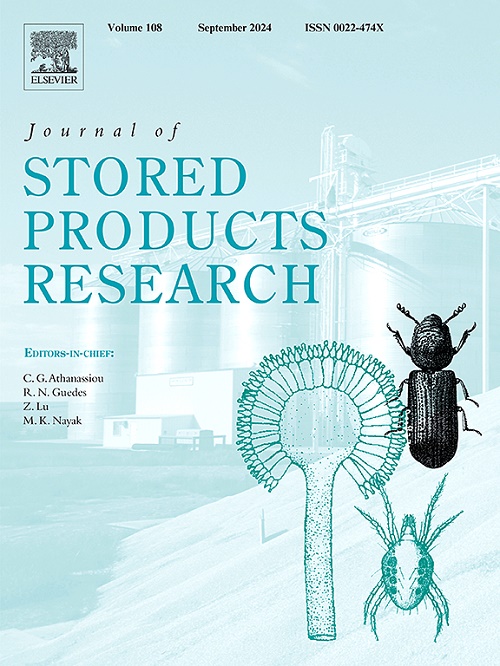Resistance evaluation of maize varieties to Sitophilus zeamais infestation across two generations: Insights for Integrated Pest Management
IF 2.7
2区 农林科学
Q1 ENTOMOLOGY
引用次数: 0
Abstract
Sitophilus zeamais (Coleoptera: Curculionidae), the main pest of stored corn grains, represents a significant challenge for agriculture. The use of resistant corn varieties appears as an effective control alternative, minimizing dependence on synthetic chemical insecticides. In this study, we evaluated the resistance performance of eight maize varieties to S. zeamais over two generations. The experiment was conducted without choice, where 50 g of grains of each variety were infested with 15 adult insects. After a period of ten days for mating and oviposition, the adult insects were discarded and the F1 generation was evaluated. Adults from the F1 generation were used to infest the grains of each variety from the F2 generation. The parameters evaluated included the total number of insects emerged, insect weight, grain mass loss, longevity, average biological cycle and susceptibility index. The results revealed significant differences between the varieties in terms of resistance to S. zeamais. In a separate experiment, with a choice option, arenas containing eight Petri dishes were used, each with 50 g of grains of each variety. 120 adult insects were released in the center of the tray. In this scenario, BRS 451 QPM corn showed resistance through the antixenosis mechanism, while Al-Bandeirantes exhibited antibiosis effects on S. zeamais insects. The results highlight the importance of evaluating the resistance effects of varieties on more than one generation of insects to confirm the resistance or susceptibility status of a variety. The corn varieties indicated as resistant in this study can be used as an environmentally friendly alternative to reduce S. zeamais infestation and minimize economic losses. Furthermore, these varieties can be incorporated into genetic improvement programs to develop future commercial cultivars resistant to S. zeamais.
两代玉米品种对嗜坐果蝇侵扰的抗性评估:虫害综合防治的启示
贮藏玉米的主要害虫嗜坐果蝇(鞘翅目:卷须科)是农业面临的一项重大挑战。使用抗性玉米品种似乎是一种有效的防治方法,可最大限度地减少对化学合成杀虫剂的依赖。在这项研究中,我们评估了八个玉米品种两代对玉米螟的抗性表现。实验是在没有选择的情况下进行的,每个品种的 50 克谷粒被 15 头成虫侵染。经过十天的交配和产卵期后,丢弃成虫,评估 F1 代。用 F1 代的成虫侵染 F2 代每个品种的谷粒。评估参数包括出虫总数、虫重、谷物质量损失、寿命、平均生物周期和易感指数。结果表明,各品种在对天牛的抗性方面存在显著差异。在另一项有选择选项的实验中,使用了装有 8 个培养皿的竞技场,每个培养皿装有每个品种的 50 克谷粒。120 只成虫被释放在培养皿中央。在这种情况下,BRS 451 QPM 玉米通过抗缺氧机制表现出抗性,而 Al-Bandeirantes 则对 S. zeamais 昆虫表现出抗生素效应。这些结果凸显了评估品种对不止一代昆虫的抗性影响以确认品种的抗性或易感状态的重要性。本研究中表明具有抗性的玉米品种可作为一种环境友好型替代品,以减少玉米螟虫害并将经济损失降至最低。此外,这些品种还可纳入遗传改良计划,以培育未来抗玉米螟的商业栽培品种。
本文章由计算机程序翻译,如有差异,请以英文原文为准。
求助全文
约1分钟内获得全文
求助全文
来源期刊
CiteScore
5.70
自引率
18.50%
发文量
112
审稿时长
45 days
期刊介绍:
The Journal of Stored Products Research provides an international medium for the publication of both reviews and original results from laboratory and field studies on the preservation and safety of stored products, notably food stocks, covering storage-related problems from the producer through the supply chain to the consumer. Stored products are characterised by having relatively low moisture content and include raw and semi-processed foods, animal feedstuffs, and a range of other durable items, including materials such as clothing or museum artefacts.

 求助内容:
求助内容: 应助结果提醒方式:
应助结果提醒方式:


